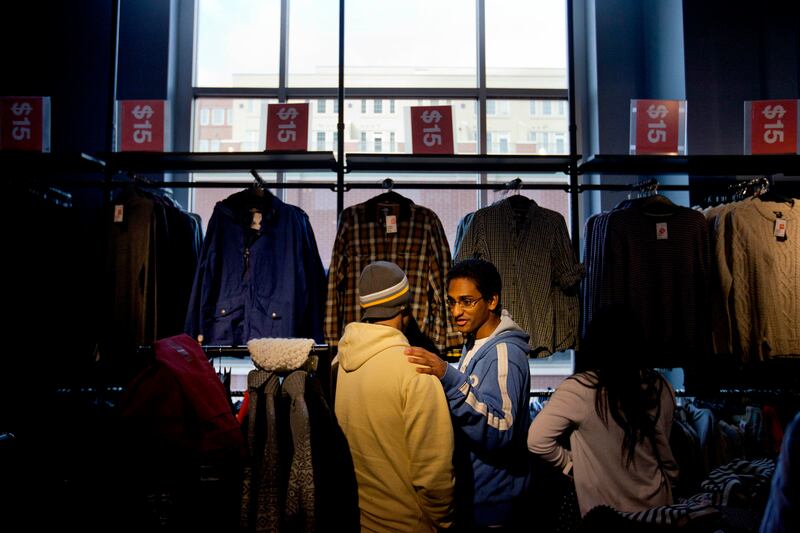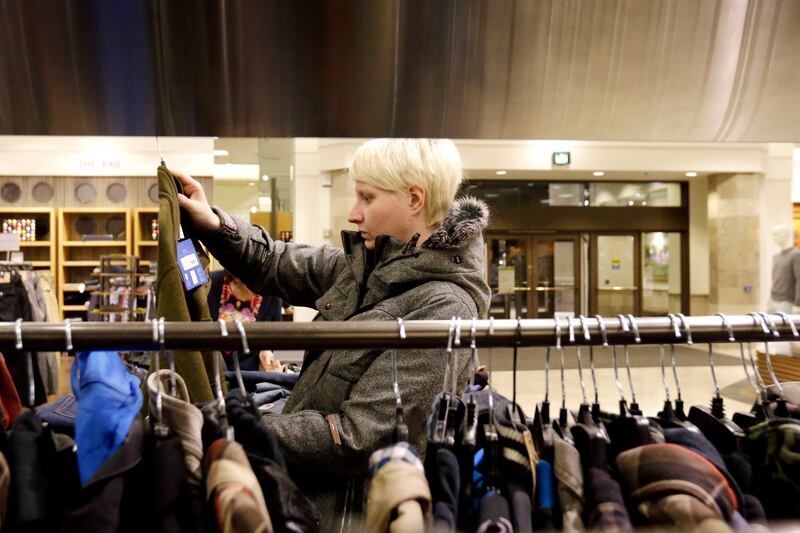If you visit public schools or public libraries, you’ll probably come across the Works Progress Administration–era social-realist murals that depict Americans—farmers, doctors, shopkeepers, laborers—going about their work with a sense of dignity. Aside from providing employment to idle painters, these Depression-era works were meant to show people calmly going about their useful social purposes in an unsettled era.

Today if I were to commission a mural highlighting the quiet heroes of our current economic era, it would look something like this: a teenager checking out at Abercrombie & Fitch; a 35-year-old mother with two kids filling the cart at Costco; a middle-aged man running into Cabela’s, stocking up on guns and ammo; a multigenerational family feasting at Olive Garden; and an office worker clicking the “buy” button on Rue La La when she should be working.
Why? Because at this stage of our expansion, which is heading toward its fourth birthday in June, shoppers are doing the heavy lifting.
The Census Bureau on Wednesday reported retail sales numbers for February. And they were impressive: up 1.1 percent from January to February and up 4.6 percent from February 2012. January’s gain was revised higher, too. To be sure, higher gas prices account for a decent chunk of the increase. But the report showed that consumers continued to spend despite of higher gas prices and all the other headwinds.
A second big number came out Wednesday. The Commerce Department reported that business inventories business inventories rose a solid 1 percent from December to January. In plain English, it meant that companies, anticipating that their sales might be higher in February and March, ordered more stuff to hold in inventory.
These numbers were surprising and caused analysts to ratchet up their projections for growth. Macroeconomic Advisers fed the data into its model and upped its fourth-quarter figure to 0.8 percent, and to 2.7 percent for the first quarter of 2013. Deutsche Bank’s economic-research team, led by economist Joseph LaVorgna, was even more optimistic. It jacked up its first-quarter GDP growth forecast from 1.5 percent to 3 percent, in part because “February retail sales surprised significantly to the upside, and there were upward revisions.”
The increase in sales is particularly important, because some of the other forces that propelled growth in the early stages of this expansion are petering out. Exports, which soared in 2010 and 2011, are showing signs of plateauing as the global economy slows. The government, which did a lot to stimulate the economy in 2009, has become a rolling force for austerity.
In recent years the job market has been brutal, and wages have been stagnant. But U.S. consumers have been working to improve their fiscal fitness. They’ve been doing exercise designed to strengthen the muscles that went flabby during the credit bubble—like smart consumption, thrift, and the intelligent management of debt.

Americans across the board are now doing a much better job keeping up with financial obligations. The Mortgage Bankers Association says that at the end of 2012, the mortgage delinquency rate was 7.09 percent, the lowest it had been since 2008, and down from 7.58 percent at the end of 2011. In the third quarter of 2012, credit-card delinquencies fell to a mere 2.7 percent rate, their lowest level since 1994, according to the American Bankers Association. In February consumer bankruptcy filings were off 21 percent from the year before.
The New York Federal Reserve’s huge consumer-credit report said that consumer credit actually rose a bit in the fourth quarter. But the long-term trend is unmistakable. Thanks to defaults, foreclosures, debt pay-downs, and a reluctance to take on new debt, total consumer credit has fallen from $12.68 trillion in the third quarter of 2008 to $11.34 trillion in the fourth quarter of 2012, a decline of $1.34 trillion, or 10.6 percent.
Yet Americans have continued to shop. Retail sales have bounced back smartly since their spring 2009 lows. Every month, in effect, they set a new record. Sales of big-ticket items like cars and homes are up sharply as well. But consumers are shopping till they drop without dropping their plastic. The level of revolving debt—i.e., credit cards—was about $851 billion in January 2013. That’s below the outstanding total in January 2006. The upshot is that American consumers are supporting a significantly higher level of retail spending with a much lower level of credit-card debt. And to the extent they are financing purchases with debt, they are doing a much, much better job staying current on their payments.
Consumers have continued to boost spending, prudently, through some fierce political headwinds: the debt-ceiling debacle of the summer of 2011, the bitter presidential campaign, the fiscal-cliff hostage situation of late 2012, the payroll-tax increase of early 2013, and this spring’s sequester. Many analysts rode the Acela corridor in a continual state of befuddlement. How can consumers ignore the Beltway meshugas?
It turns out we (including me) put way too much stock on how the shenanigans in Washington impact consumption decisions and behavior. Most Americans—in fact, the overwhelming majority of Americans—don’t spend so much time paying attention to politics. (To see just how few people actually watch cable news, check out TVNewser’s humbling nightly scoreboard).
More significant, the powerful forces that support higher retail sales and consumption are moving in the right direction. Americans tend to spend almost all of what they earn. And in February 2013, nearly 2 million more Americans were working at payroll jobs than in February 2012—and they were working at slightly higher wages. In the past three years the private sector has added well over 6 million positions. The wages these jobs inject into the economy more than outweigh the impact of the payroll-tax increase and the sequester. Add in the rising stock market and improving housing market, which tend to make people feel more wealthy, and it should come as no surprise that retail sales are rising.
Politicians will continue, loudly, to do their thing. Republicans will continue to avoid a grand bargain and instigate crises. The White House will continue to underestimate Republicans’ willingness to do so. Congressional Democrats will tug their chins and grumble. And the centrist-deficit-hawk complex will clamor for a grand bargain and leadership.
Amid it all, America’s heroic consumers will quietly soldier on. Keep calm and shop on.






